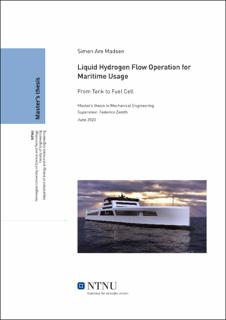| dc.contributor.advisor | Zenith, Federico | |
| dc.contributor.author | Madsen, Simen Are | |
| dc.date.accessioned | 2021-09-20T16:45:32Z | |
| dc.date.available | 2021-09-20T16:45:32Z | |
| dc.date.issued | 2020 | |
| dc.identifier | no.ntnu:inspera:57316519:20929502 | |
| dc.identifier.uri | https://hdl.handle.net/11250/2779603 | |
| dc.description.abstract | Denne oppgaven har som målsetning å beskrive strømningsprosesser til hydrogen innenfor maritime bruksområder. Denne problemstillingen ble løst ved å studere Topeka konseptet som består av base-til-base lasteskip som benytter flytende hydrogen som drivstoff. Vi beskrev først selve konseptet før vi fulgte flyten av hydrogen. Flyten starter i lagringstanken lokalisert ved kaianlegget, hvor bunkringsprosessen finner sted. Etter hydrogenet er bunkret på skipets drivstofftank så beskrev vi skritt for skritt hydrogenets reise fra hovedtanken, via forberedelsestankene, gjennom fordamperen og varmeveksleren og inn i brenselscellen. Vi har også diskutert noen bredere aspekt rundt konseptet ved å se på hele skipet som et helhetlig system hvor vi eksaminerte fremdrift og kraftetterspørselen. Avslutningsvis så utforsket vi mulighetene for å øke batterienes kapasitet og kombinere dette med land-strøm fra havnene til å oppnå et plug-in hybrid fremdriftssystem. Dette ble utført for å kunne optimalisere skipet som et nullutslipps fartøy.
Metodikken vi benyttet oss av i denne oppgaven var å kombinere den informasjonen vi fikk av de industrielle aktørene som er involvert med relevant teknisk teori. Disse delbeskrivelsene ble satt sammen til en helhetlig beskrivelse. De deltakende bedriftene driver hovedsakelig innen skipsdesign, gassteknologi og rederivirksomhet. Vi tok dataene som ble delt med oss og utforsket det fra et teoretisk perspektiv hvor vi utforsket fundamentale aspekter bak design valgene. Disse diskusjonene ble sammensatt til en oppgave som følger hydrogen strømmen gjennom systemet, som en direkte respons på energibehovet som oppstår fra en gitt skips hastighet.
Resultatet vi kom frem til viser at det er mulig å designe og bygge et skip som kan opprettholde en regulær og forutsigbar rutetabell langs kysten, drevet av flytende hydrogen. Basert på vår analyse så anser vi det vi det som overkommelig å drifte en bunkringsstruktur som kan tilby tilstrekkelig med drivstoff for ruten. Selve hydrogen strømningsprosessene om bord kan utføres med dagens teknologi. Design valget ved å kombinere kjølesystemet til brenselscellene med varmeveksleren til hydrogenet viste seg mulig fra et energibalanse-perspektiv. Utregninger viste tydelig at desto høyere trykk på hydrogenet inn i cellen, desto mer energi vil konsumeres av luft kompressorene. Vi kom frem til at ved å øke batterikapasiteten og skalere den etter den tilgjengelige landstrømmen ved havnene så er det gjennomførbart å oppnå en plug-in hybrid løsning. Dette vil øke drivstofføkonomien og forbedre påliteligheten til systemet. | |
| dc.description.abstract | The goal of this paper is to describe liquid-hydrogen flow operations for maritime applications. This was done by studying the Topeka base-to-base liquid hydrogen cargo vessel concept. We described the project, then followed the flow of hydrogen. First, from the tank on land, then through the bunkering process to the vessel fuel tank. Onboard, we reviewed step by step the hydrogen’s journey from the main tank to the conditioning tank, through the evaporator and heat exchanger, and into the fuel cell. We also described the broader aspects of the ship as a full energy system by discussing the propulsion and power demand. Finally, we examined the possibility of increasing the capacity of the battery pack to combine land-power and hydrogen into a plug-in hybrid propulsion set-up to optimize the ship as a zero-emission vessel.
The methodology was to combine the information provided by the industrial players involved with the relevant engineering theory and then aggregate the results into a full system description. The project participants were mainly engineering companies focusing on naval architecture and cryogen gas technology and shipping companies focusing on owning and operating the tonnage on the water. We took the data that was shared with us and examined it from a theoretical perspective, describing the fundamentals behind the choices. These descriptions and discussions were cumulated into a paper that follows the flow of fuel through the system, as a response to the energy demand created by a given vessel velocity on the ocean.
The conclusion was that it is fully feasible to design and build a ship that can support a regular and predictable timetable sailing along the coast, powered by hydrogen in its liquid form. Based on our assessment, we deem it conceivable to operate a bunkering structure that can supply adequate fuel for the route. The hydrogen flow processes onboard can be performed with today’s technology. The decision to combine the cooling cycle of the fuel cells and the heating cycle of the cryogen fuel is possible from an energy balance point-of-view. It became apparent that the higher pressure used on the hydrogen into the cell, the more energy is consumed by the air compression. We determined that by increasing the battery capacity and scale it to the available electrical grid power capacity on the ports of call, a plug-in hybrid system could improve fuel economics and reliability. | |
| dc.language | | |
| dc.publisher | NTNU | |
| dc.title | Liquid Hydrogen Flow Operation for Maritime Usage | |
| dc.type | Master thesis | |
